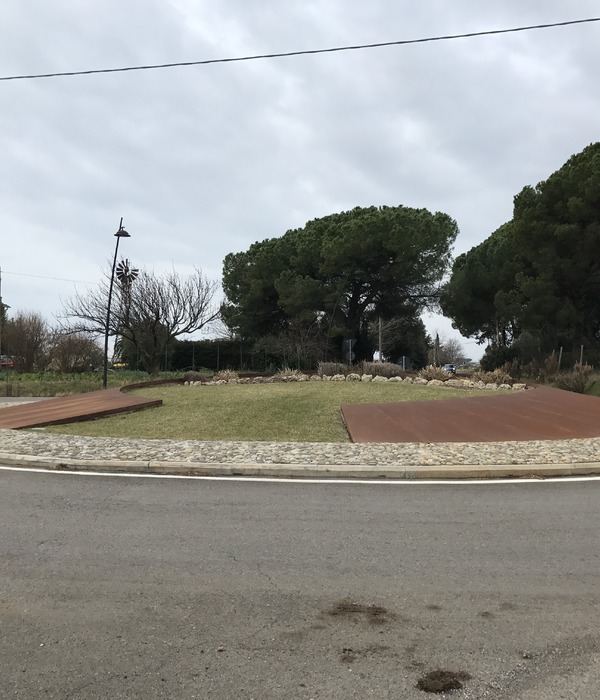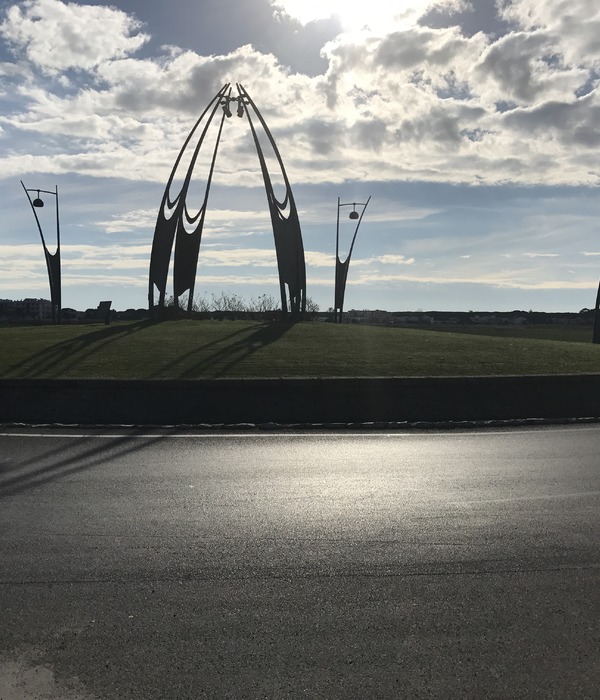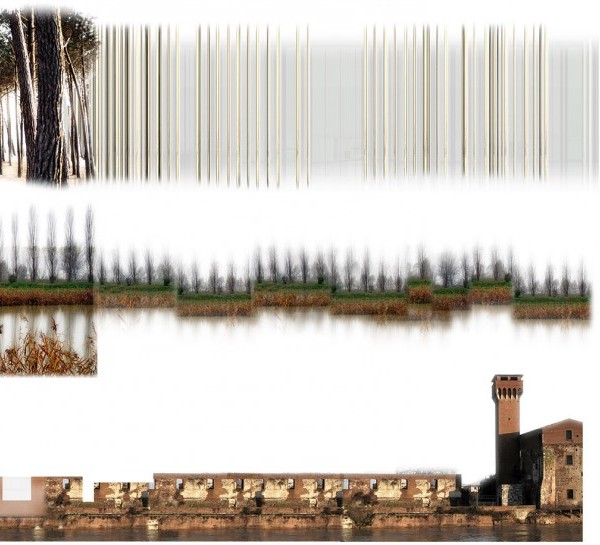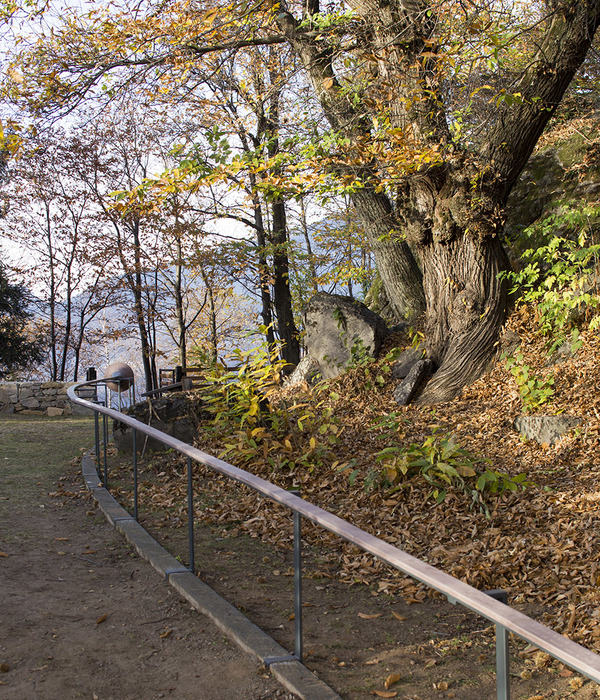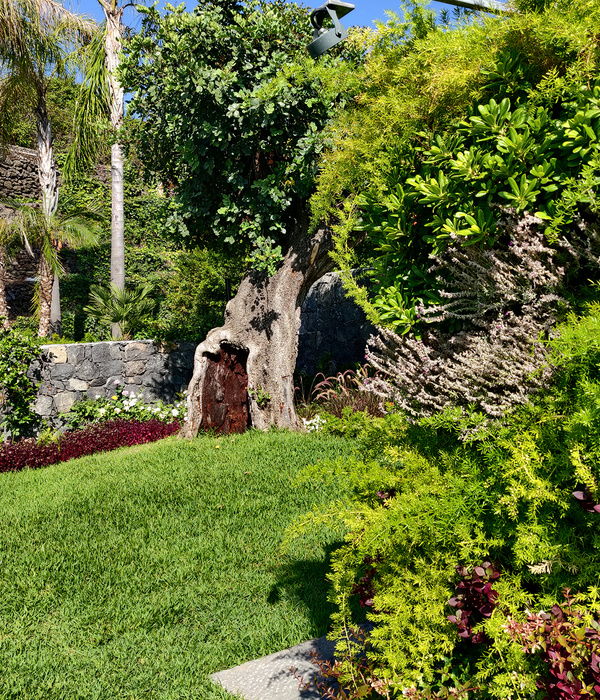本项目位于广州,依托原有约150年历史的古炮台群,在原址山上建设海防教育历史公园。项目主要对炮台及其周边环境进行提升,设计内容包括历史公园入口、室内展陈、沿路展陈与标识系统,总设计范围约10000㎡。
The project, located in Guangzhou, is a historical park of defense education built on the mountain, based on the original ancient forts with a history of about 150 years. This project mainly aims to improve the forts and their surrounding environment. The design content includes the entrance of the historical park, an indoor exhibition hall, linear exhibitions along with the road and identification systems, with a total design scope of about 10,000㎡.
▼项目概览,overall of the project ©吴嗣铭 Siming Wu
项目所在地周边有着一套完整的炮台防御系统,炮台保存较好。在设计中,我们主要考虑到了项目所在的环境具有重要的历史意义与生态意义,因此设计需要融入环境的同时,应该克制对环境的改变,除了不能对炮台本体产生破坏之外,对于山体、道路也应该尽量减少影响。
▼入口原貌,original entrance © 竖梁社 Atelier cnS
There is a complete fort defense system around the site, which is well preserved. During the design process, we mainly consider the enormous historical and ecological significance of the site. Therefore, the design needs to be integrated into the environment, and it should also refrain from triggering any environmental changes, which means besides not damaging the forts themselves, we should also minimize the environmental impact on mountains and roads.
▼轴测图,axonometric drawing © 竖梁社 Atelier cnS
▼分析图,diagram © 竖梁社 Atelier cnS
项目的入口位于一个半山腰上的十字路口,指向不明确。同时入口旁边原有一个多年前建设的公厕,观感上较为消极。为了增强项目入口的可识别性,同时对公厕进行一定的遮蔽,我们使用了当地的石料与锈钢板制作一个垒石墙,形成整个历史公园的入口,而墙体本身成为了一个标识点,其上的穿孔耐候钢板则对背后的公厕有一定的遮蔽作用。钢笼之中砌石的做法为石墙形态上的多变带来了可能性,而耐候钢与石料材质的搭配带给了这个大门沉稳的历史感。
The entrance of the project is located at an unobvious crossroad on the hillside, and there is a tourist public toilet next to the entrance, which is negative and unaesthetic visually. In order to enhance the recognition of the entrance of the project and shield the public toilet, we build a stone wall as the entrance of the historical park using local stones and rusty steel plates. While the wall itself became a marking point, the rusted steel plate on it can shield the public toilet behind it. The construction detail of stacking stones in the steel cage brings more possibility to the diversity of the wall’s form, and the combination of the rusted steel and stone materials brings a steady historical sense to the entrance.
▼项目入口,entrance design ©吴嗣铭 Siming Wu
▼穿孔耐候钢板则对背后的公厕有一定的遮蔽作用,the rusted steel plate on it can shield the public toilet behind it ©吴嗣铭 Siming Wu
▼当地石料与锈钢板制作的垒石墙,the stone wall as the entrance of the historical park ©吴嗣铭 Siming Wu
▼由小路看入口与石墙,viewing the entrance and the stone wall from the path ©吴嗣铭 Siming Wu
之后的道路两侧,我们做了一系列的沿路展陈,展览内容主要是关于近现代与炮台相关的历史。为了保持游客对道路两边自然环境的视线通透,我们设计了一系列的随机穿孔的耐候钢板。展览内容印在半透明的亚克力板上,通过卯钉固定在穿孔耐候钢板上,通过模数的控制,我们实现了展览内容的自由调整。通透的展示墙和背后绿荫融合一起呈现游人面前。
After that, we design a series of exhibitions along both sides of the road. The exhibitions are mainly about modern and contemporary history related to the forts. To make sure it is transparent for the tourists’ sight of the natural environment on both sides of the road, we design a series of randomly rusted steel plates. The exhibition contents are printed on translucent acrylic boards and fixed on the rusted steel boards by nails. By controlling the modulus, we can freely adjust the exhibition content. The transparent display wall and the green shade behind it are combined and presented to visitors.
▼沿路展陈保持了游客对路边自然环境的视线通透,the plates make sure it is transparent for the tourists’ sight of the natural environment on both sides of the road ©吴嗣铭 Siming Wu
▼沿路展陈,exhibitions along both sides of the road ©吴嗣铭 Siming Wu
▼穿孔耐候钢板的展架,Display frame of perforated rusted steel plates ©吴嗣铭 Siming Wu
在整个项目中,我们主要关注点在于如何创造一个适应“此地”的设计。材质的选择上,我们希望设计能够融入环境,并能够体现历史的沉重,因为太跳脱太张扬的设计虽然富有个性,但并不适合出现在一个这么严肃的场所。
In the whole project, our main concern is to create a design suitable for “the site”. In the choice of materials, we hope that the design can integrate into the environment and reflect the real history, as an over-detached and exaggerated design is full of personality but not suitable for such a serious place.
▼原有古炮台群,original ancient forts ©吴嗣铭 Siming Wu
炮台群附属的旧有红砖砌筑的拱形结构建筑中,我们对其进行了清理和修复,并更新了室内展览的形式和内容,然后配合其特征增加了灯光——朝向下方的射灯满足了展览的需求,而朝向上方的线条灯则恰到好处地衬亮了原来的红砖拱顶,形成旧中有新的意向。
Attached to the forts, the vaulted building built by old red bricks is cleaned and repaired. We update the form and content of the indoor exhibition and then add lights according to its original characteristics. The spotlights facing downward meet the demands of the exhibitions, while the linear lights facing upward appropriately brighten the original red brick vault, forming a “new in the old” concept.
▼室内展陈,indoor exhibition design ©吴嗣铭 Siming Wu
▼红砖砌筑的拱形结构建筑得到了修复,the red-brick arch structure has been restored ©吴嗣铭 Siming Wu
▼红砖拱顶,the original red brick vault ©吴嗣铭 Siming Wu
而在建造方式上,我们希望能够为以后的转变提供更多的可能性与可逆性,以保护历史遗址为原则,采取了比较轻巧的改造方式,同时当日后展览的内容/形式需要变化时,他们可以在我们设计的基础上进行替换,这样能够减少对周边环境的破坏。
In terms of the construction method, we hope to provide more possibilities and reversibility for future changes. Therefore, we adopt a lighter transformation method based on the principle of protecting the historical site. At the same time, when the contents or forms of future exhibitions need to be changed, they can be replaced based on our design, which can reduce the damage to the surrounding environment.
▼耐候钢板与穿孔钢板细部,Details of the rusty steel and perforated steel plates © 竖梁社 Atelier cnS
▼石材与原有红砖拱顶细部,details of the stone and the original brick vault © 竖梁社 Atelier cnS
▼总平面图,master plan © 竖梁社 Atelier cnS
▼立面图,elevation © 竖梁社 Atelier cnS
▼剖面图,section © 竖梁社 Atelier cnS
{{item.text_origin}}

